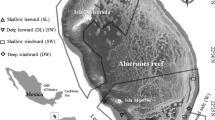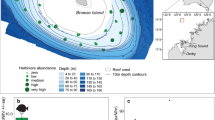Abstract
The composition and functionality of ecologically important herbivorous fish assemblages were examined throughout much of Australia’s Great Barrier Reef (GBR). Diversity and abundance of surgeonfishes (Acanthuridae), parrotfishes (Labridae) and rabbitfishes (Siganidae) were strongly associated with position on the continental shelf, whilst effects of latitude were weaker and inconsistent. Species distributions varied considerably amongst taxonomic groups; parrotfishes were mostly widespread whilst distributions of surgeonfishes were often restricted. Most inshore environments supported depauperate herbivore assemblages dominated by different taxa and functional groups compared with assemblages in offshore environments. There were also strong cross-shelf transitions in the main taxa performing each functional role. Overall, this study show that the functional contributions of herbivorous fish assemblages to important ecosystem processes and the contributing taxa vary considerably amongst different GBR environments. Additionally, the two most numerically dominant herbivores actively select detritus, not algae, supporting increasing evidence for the importance of detritus in coral reef ecology.






Similar content being viewed by others
References
Afeworki Y, Bruggemann JH, Videler JJ (2011) Limited flexibility in resource use in a coral reef grazer foraging on seasonally changing algal communities. Coral Reefs 30:109–122
Bellwood DR (1996) Production and reworking of sediment by parrotfishes (family Scaridae) on the Great Barrier Reef, Australia. Mar Biol 125:795–800
Bellwood DR, Choat JH (1990) A functional analysis of grazing in parrotfishes (family Scaridae): the ecological implications. Environ Biol Fish 28:189–214
Bellwood DR, Wainwright PC (2001) Locomotion in labrid fishes: implications for habitat use and cross-shelf biogeography on the Great Barrier Reef. Coral Reefs 20:139–150
Bellwood DR, Hughes TP, Folke C, Nystrom M (2004) Confronting the coral reef crisis. Nature 429:827–833
Bellwood DR, Hughes TP, Hoey AS (2006) Sleeping functional group drives coral-reef recovery. Curr Biol 16:2434–2439
Bellwood DR, Hoey AS, Hughes TP (2011) Human activity selectively impacts the ecosystem roles of parotfishes on coral reefs. Proc R Soc B. doi:10.1098/rspb.2011.1906
Bennett S, Bellwood DR (2011) Latitudinal variation in macroalgal consumption by fishes on the Great Barrier Reef. Mar Ecol Prog Ser 426:241–252
Birrell CL, McCook LJ, Willis BL, Diaz-Pulido GA (2008) Effects of benthic algae on the replenishment of corals and the implications for the resilience of coral reefs. Oceanogr Mar Biol 46:25–64
Burkepile DE, Hay ME (2010) Impact of herbivore identity on algal succession and coral growth on a Caribbean reef. PLoS ONE 5(1):e8963
Cheal AJ, MacNeil MA, Cripps E, Emslie MJ, Jonker M, Schaffelke B, Sweatman H (2010) Coral-macroalgal phase shifts or reef resilience: links with diversity and functional roles of herbivorous fishes on the Great Barrier Reef. Coral Reefs 29:1005–1015
Choat JH (1991) The biology of herbivorous fishes on coral reefs. In: Sale PF (ed) The ecology of fishes on coral reefs. Academic, San Diego, pp 120–155
Choat JH, Clements KD, Robbins WD (2002) The trophic status of herbivorous fishes on coral reefs. I. Dietary analyses. Mar Biol 140:613–624
Choat JH, Robbins WD, Clements KD (2004) The trophic status of herbivorous fishes on coral reefs II. Food processing modes and trophodynamics. Mar Biol 145:445–454
Crossman DJ, Choat JH, Clements KD (2005) Nutritional ecology of nominally herbivorous fishes on coral reefs. Mar Ecol Prog Ser 296:129–142
Done TJ (1982) Patterns in the distribution of coral communities across the central Great Barrier Reef. Coral Reefs 1:95–107
Floeter SR, Behrens MD, Ferreira CEL, Paddack MJ, Horn MH (2005) Geographical gradients of marine herbivorous fishes: patterns and processes. Mar Biol 147:1435–1447
Fox RJ, Bellwood DR (2007) Quantifying herbivory across a coral reef depth gradient. Mar Ecol Prog Ser 339:49–59
Fox RJ, Sunderland TL, Hoey AS, Bellwood DR (2009) Estimating ecosystem function: contrasting roles of closely related herbivorous rabbitfishes (Siganidae) on coral reefs. Mar Ecol Prog Ser 385:261–269
Froese R, Pauly D (eds) (2009) FishBase. http://www.fishbase.org
Goatley CHR, Bellwood DR (2010) Biologically mediated sediment fluxes on coral reefs: sediment removal and off-reef transportation by the surgeonfish Ctenochaetus striatus. Mar Ecol Prog Ser 415:237–245
Green AL, Bellwood DR (2009) Monitoring functional groups of herbivorous fishes as indicators of coral reef resilience—a practical guide for coral reef managers in the Asia Pacific region. IUCN working group on climate change and coral reefs. IUCN, Gland, Switzerland
Gust N (2002) Scarid biomass on the northern Great Barrier Reef: the influence of exposure, depth and substrata. Environ Biol Fish 64:353–366
Gust N, Choat JH, McCormick MI (2001) Spatial variability in reef fish distribution, abundance, size and biomass: a multi scale analysis. Mar Ecol Prog Ser 214:237–251
Halford AR, Thompson AA (1996) Visual census surveys of reef fish. Australian Institute of Marine Science, Townsville
Hoey AS, Bellwood DR (2008) Cross-shelf variation in the role of parrotfishes on the Great Barrier Reef. Coral Reefs 27:37–47
Hoey AS, Bellwood DR (2010) Limited functional redundancy in a high diversity system: single species dominates key ecological process on coral reefs. Ecosystems 12:1316–1328
Mumby PJ (2006) The impact of exploiting grazers (Scaridae) on the dynamics of Caribbean coral reefs. Ecol Appl 16:747–769
Mumby PJ, Hastings A, Edwards HJ (2007) Thresholds and the resilience of Caribbean coral reefs. Nature 450:98–101
Nemeth M, Appeldoorn R (2009) The distribution of herbivorous coral reef fishes within fore-reef habitats: the role of depth, light and rugosity. Caribb J Sci 45:247–253
Nyström M, Graham NAJ, Lokrantz J, Norström AV (2008) Capturing the cornerstones of coral resilience: linking theory to practice. Coral Reefs 27:795–809
Purcell SW, Bellwood DR (1993) A functional analysis of food procurement in two surgeonfish species, Acanthurus nigrofuscus and Ctenochaetus striatus (Acanthuridae). Environ Biol Fish 37:139–159
Russ G (1984a) Distribution and abundance of herbivorous grazing fishes in the central Great Barrier Reef. I. Levels of variability across the entire continental shelf. Mar Ecol Prog Ser 20:23–34
Russ G (1984b) Distribution and abundance of herbivorous grazing fishes in the central Great Barrier Reef. II. Patterns of zonation of mid-shelf and outer shelf reefs. Mar Ecol Prog Ser 20:35–44
Russ GR (2003) Grazer biomass correlates more strongly with production than with biomass of algal turfs on a coral reef. Coral Reefs 22:63–67
Russ GR, McCook LJ (1999) Potential effects of a cyclone on benthic algal production and yield to grazers on coral reefs across the central Great Barrier Reef. J Exp Mar Biol Ecol 235:237–254
Sabater MG, Tofaeono SP (2007) Scale and benthic composition effects on biomass and trophic group distribution of reef fishes in American Samoa. Pac Sci 61:503–520
Steneck RS (1997) Crustose corallines, other algal functional groups, herbivores and sediments: complex interactions along reef productivity gradients. In: Proceedings of 8th international Coral Reef symposium, Balboa, Panama, pp 695–700
Sweatman H, Cheal AJ, Coleman GJ, Emslie MJ, Johns K, Jonker M, Miller IR, Osborne K (2008) Long term monitoring of the Great Barrier Reef. Status report no. 8. Australian Institute of Marine Science, Townsville
Trip EL, Choat JH, Wilson DT, Robertson DR (2008) Interoceanic analysis of demographic variation in a widely distributed Indo-Pacific Coral Reef fish. Mar Ecol Prog Ser 373:97–109
Walker BH (1992) Biodiversity and ecological redundancy. Conserv Biol 6:18–23
Westneat MW, Alfaro ME (2005) Phylogenetic relationships and evolutionary history of the reef fish family Labridae. Mol Phylogenet Evol 36:370–390
Wilkinson CR, Cheshire AC (1988) Cross-shelf variations in coral reef structure and function—influences of land and ocean. In: Proceedings of 6th international Coral Reef symposium, Townsville, pp 227–233
Williams DMcB (1982) Patterns in the distribution of fish communities across the central Great Barrier Reef. Coral Reefs 1:35–43
Williams DMcB, Hatcher AI (1983) Structure of fish communities on outer slopes of inshore, mid-shelf and outer shelf reefs of the Great Barrier Reef. Mar Ecol Prog Ser 10:239–250
Wilson SK, Bellwood DR, Choat JH, Furnas MJ (2003) Detritus in the epilithic algal matrix and its use by coral reef fishes. Oceanogr Mar Biol 41:279–309
Winterbottom R, McLennan DA (1993) Cladogram versatility: evolution and biogeography of Acanthuroid fishes. Evolution 47:1557–1571
Wismer S, Hoey AS, Bellwood DR (2009) Cross-shelf benthic community structure on the Great Barrier Reef: relationships between macroalgal cover and herbivore biomass. Mar Ecol Prog Ser 376:45–54
Acknowledgments
We thank members of the AIMS long-term monitoring team and the crew of research vessels, past and present, for their various contributions to the collection of data used in this study. The helpful comments of three anonymous reviewers are also appreciated. The study was supported by AIMS, the CRC Reef Research Centre and the Australian Governments’s Marine and Tropical Sciences Research Facility.
Author information
Authors and Affiliations
Corresponding author
Additional information
Communicated by D. Goulet.
Rights and permissions
About this article
Cite this article
Cheal, A., Emslie, M., Miller, I. et al. The distribution of herbivorous fishes on the Great Barrier Reef. Mar Biol 159, 1143–1154 (2012). https://doi.org/10.1007/s00227-012-1893-x
Received:
Accepted:
Published:
Issue Date:
DOI: https://doi.org/10.1007/s00227-012-1893-x




